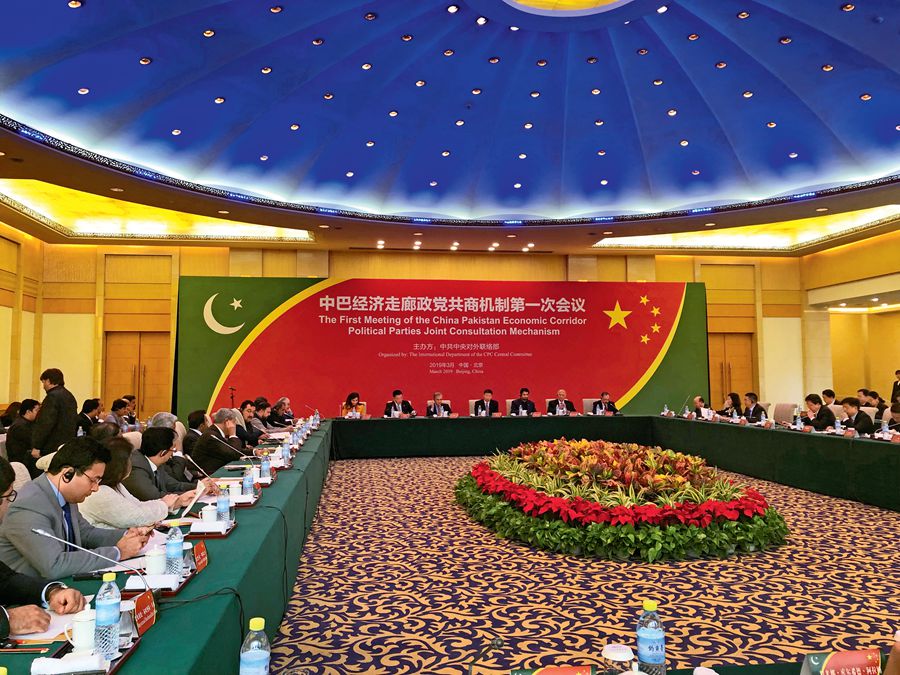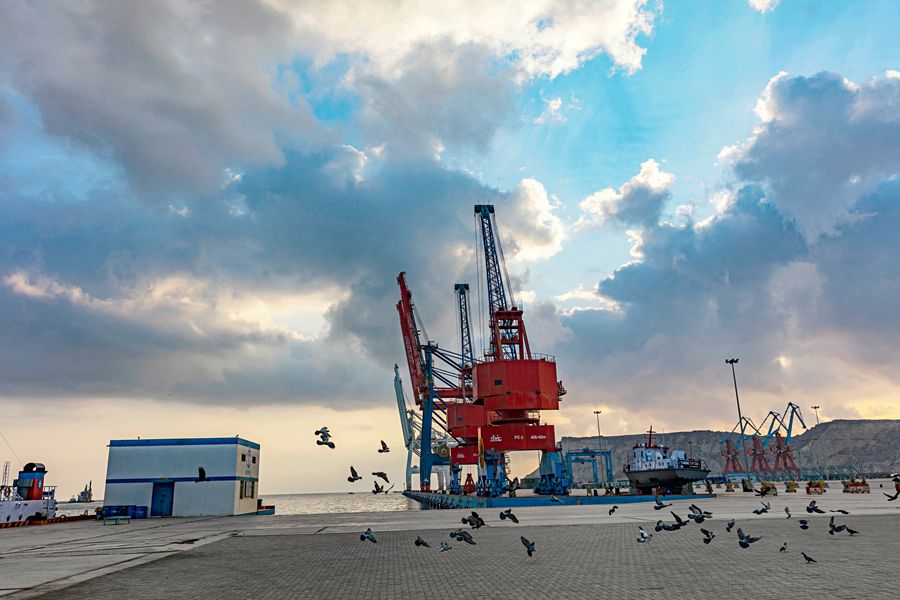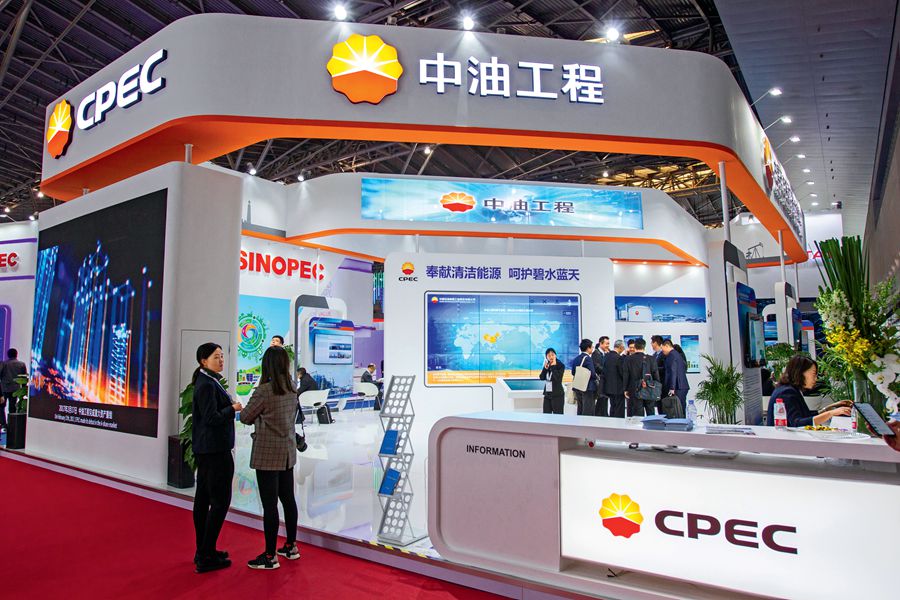THE conception of building the China-Pakistan Economic Corridor (CPEC) was first proposed by Premier Li Keqiang during his visit to Pakistan in May 2013, with the goal to promote connectivity and common development between the two countries.
On April 20, 2015, during his state visit to Pakistan, President Xi Jinping put forward the idea to form a ‘1+4’ cooperation structure with the CPEC at the center, and achieve common development by focusing on the four key areas of the Gwadar Port, energy, transport infrastructure, and industrial cooperation.
The CPEC is a 3,000-kilometer network of roads, railways, oil and gas pipelines, and optical cable covering an area that stretches from southern Pakistan’s Gwadar Port to Kashgar city in northwestern China’s Xinjiang Uygur Autonomous Region. Connecting both the Silk Road Economic Belt and the 21st Century Maritime Silk Road, the CPEC is playing a vital role in building the Belt and Road.

The first meeting of the CPEC Political Parties Joint Consultation Mechanism is held in Beijing on March 19, 2019, as an important communication platform for the two countries to advance the China-Pakistan Economic Corridor construction.
On March 19, 2019, after co-chairing the first China-Pakistan Foreign Ministers’ Strategic Dialogue in Beijing with Foreign Minister Shah Mahmood Qureshi of Pakistan, State Councilor and Foreign Minister Wang Yi told reporters that the CPEC is a landmark project of China-Pakistan cooperation in the new era, and is also an important pioneering project of the Belt and Road Initiative (BRI). He further pointed out that the CPEC encompasses the whole country of Pakistan, rather than confined to some specific regions. According to the prospects and planning of the CPEC agreed on by both sides, the CPEC projects will be expanded in the future, so they can benefit a wider range of people.
A Mega Program with Far-reaching Influence
Approved by the two governments, the Long-term Plan (2017-2030) of the CPEC was released in December 2017. The plan aligns the BRI with Pakistan’s development plan Vision 2025, and outlines key fields for bilateral cooperation including connectivity, energy, trade, industrial park development, agriculture, poverty alleviation, people’s livelihood, and finance.
Since the launching of the CPEC construction, multiple joint consultation and dialogue mechanisms have been established to facilitate the bilateral consultation and coordination regarding the mega program, for example, the CPEC Political Parties Joint Consultation Mechanism and the CPEC Joint Cooperation Committee.
At the first meeting of the CPEC Political Parties Joint Consultation Mechanism held on March 19, 2019, Song Tao, Minister of the International Department of the CPC Central Committee indicated that being the flagship project of the Belt and Road construction, the building of the CPEC has made great headway. As many as 22 projects are in the process of construction or have already been completed with a total investment of US $19 billion. This, as a result, has created more than 70,000 jobs for Pakistani people, and greatly boosted the host country’s economic growth.

Since Chinese Overseas Ports Holding Company (COPHC) took over its operation, Gwadar Port has taken on a brand-new look.
As for the financing issue that has drawn lots of worldwide concern, China’s Foreign Minister Wang Yi said the Chinese side has directly invested in or provided free grants for over 80 percent of the current CPEC projects, leaving less than 20 percent of the total financed by Chinese loans. Therefore, the CPEC projects have not increased the burden of the Pakistani side. On the contrary, they provide help for and inject vitality into the local Pakistani economy.
Zhai Dongsheng, Director General of the Belt and Road Initiative Center affiliated with the National Development and Reform Commission, indicated at the first meeting of the CPEC Political Parties Joint Consultation Mechanism that seven energy projects had gone into operation with an annually generated electric power totaling 19.5 billion kilowatt-hours. The electricity is expected to meet the power demand of about 8.6 million households in Pakistan. According to Zhai, another five power generation projects are also under way. As for the transportation field, three projects have been started with a total investment of US $5.8 billion.
Zhai Dongsheng also noted that the two sides have agreed to deepen their cooperation to improve local people’s livelihoods, involving such fields as agriculture, education, healthcare, water supply, poverty alleviation, and vocational training. To quicken the process of Pakistan’s industrialization, the two sides will advance the overall construction of Gwadar and speed up such construction projects of aid including the new international airport, a sea water desalination factory, a friendship hospital, and a vocational school.
Win-Win Cooperation Story Unfolds in Gwadar
When talking about the construction of the Gwadar Port, Zhang Baozhong, chairman of Chinese Overseas Ports Holding Company (COPHC), seemed quite proud and excited, as his company has turned the former desolate place into a vibrant international trade port. “I think worldwide attention on the port construction is mainly triggered by three factors: its complexity, incredible speed of progress, and complete support by the people,” Zhang said at the CPEC first consultation meeting between political parties.

China Petroleum Engineering Co., Ltd. showcases its construction projects along the China-Pakistan Economic Corridor at the 19th International Conference & Exhibition on Liquefied Natural Gas (LNG2019) held in Shanghai on April 2.
It has been a long-cherished dream for Pakistan’s government and people to develop shipping and trade in Gwadar by leveraging the local advantageous geographical location, to promote local economic and social development. However, eight years after the first construction was completed in 2005, Gwadar Port still looked like an impoverished fishing village without one single regular liner. Its turn finally came in 2013 when COPHC took over the operation and development of Gwadar without any change of the original operation agreement about the port.
Zhang still vividly remembers how the port looked when his company first arrived. It was an endless drab sandy stretch, where local people had a hard life, having no access to electricity or adequate fresh water. Six years later, significant changes have occured here. With more than US $50 million of investment, bumpy roads have been smoothed, dilapidated warehouses renovated, and nearly abandoned sea water desalination factories restarted. With a storage yard of 100,000 sq. meters, and five installed container cranes, Gwadar Port is becoming the port with the highest operation efficiency in the region. And the operation of the Gwadar Gulf Express for container vessels has realized the linkage between Gwadar and major world ports.
In addition, the Gwadar free trade zone phase I opened for business on January 28, 2018 after a two-year construction with a total investment of US $150 million. Within the free trade zone, investors are able to enjoy a pleasant working environment with all-day-long service in electricity, water, telecommunication, and security. Having absorbed an investment of nearly RMB 3 billion, the free trade zone is expected to provide 10,000 jobs for the region with an annual output of RMB 1 billion after all the projects are put into production.
Meanwhile, COPHC has also proactively performed its social responsibility in Pakistan. Since May 2018, the company has provided local citizens with 300,000 gallons of fresh water per day, which has greatly relieved the local water shortage. Moreover, the company has also launched a tree planting initiative, and participated in aiding the construction of a school and a medical emergency center.
In Zhang’s eyes, his company’s achievements are inseparable from government’s and peoples’ support of the two countries. “I often told reporters Gwadar is a safer place than Paris and New York,” Zhang said. Over the past five years, the Gwadar Port has maintained an impeccable record of zero crime, accident, and casualty rate.
Support from All, Benefits All
Since its initiation, the CPEC has gained support from all sectors of Pakistani society. Pakistan’s Prime Minister Imran Khan indicated in a domestic meeting held in January that the completed CPEC projects were in the interests of Pakistan and would bring the country great opportunities for social and economic development. Imran Khan hoped the CPEC building could be sped up, and gave instructions to set up a CPEC business advisory committee, providing the government with policy suggestions in relation to advancing the construction of the CPEC industrial parks.
“The CPEC is not just important for China and Pakistan. Once this project comes to a full completion, it will be very beneficial for the whole region as well,” Qasim Suri, a Pakistan Tehreek-e-Insaf (PTI) leader, deputy speaker of the National Assembly of Pakistan, indicated at the first meeting of the CPEC Political Parties Joint Consultation Mechanism in March. He felt the mega program is a promising and historic opportunity for great development of Pakistan.
“The CPEC construction has not only created lots of projects, but also given our people a great chance to get skilled and then contribute those skills to the projects and earn a good livelihood,” Qasim Suri said. He applauded Chinese companies on their great performance of social duties. He also expected that the fields for bilateral cooperation under the BRI framework would continue to expand so that Pakistan can learn more from China’s experience.
At the consultation meeting, Mushahid Hussain, a leader of Pakistan Muslim League (Nawaz) and chair of the Senate Foreign Affairs Committee, noted that the way Pakistan is benefiting from the CPEC could be analyzed from three aspects. “First, when President Xi Jinping came to Pakistan in April 2015, he inspired a lot of confidence in Pakistani people. No country in the world, no Muslim country, no Western country was willing to invest in Pakistan at that time. CPEC has shaped the image of Pakistan into an investor and tourism friendly country, and a country with a bright future, all thanks to our best friend China. Second, the CPEC is giving new hope, confidence, and faith in the future. Being a factor of national unity, it has united the federation of Pakistan, the provinces, the parliament, and the political parties in the quest for a better tomorrow. Third, Thanks to the CPEC, Pakistan today is at the heart of regional connectivity between South Asia, Central Asia, and China,” Mushahid Hussain said.
At the meeting, vice president of Pakistan People’s Party Parliamentarian (PPP-P) and chair of the Senate CPEC Committee, Sherry Rehman, emphasized three “Cs (consensus, clarity, and communication)” in China-Pakistan cooperation. “To make consultation more effective, we need better consensus. There is complete unanimity in Pakistan on the CPEC opportunity. It is a platform that goes beyond parties. Its influence stretches beyond provinces and guarantees Pakistan’s entry into the 21st century as a viable economy that is able to provide its citizens basic economic benefits for health, education, and job security. But more than this, we should reach a clear consensus on the priority fields for cooperation. Therefore we should identify target areas for priority.” Rehman suggested six priority fields, respectively trade, industrial development, poverty reduction, agricultural modernization, blue economy, and regional connectivity.
Last but not least, she regarded communication as a very important factor in facilitating the progress of CPEC projects. She indicated the necessity that different provinces of Pakistan have adequate communication as to specific plans and goals about the CPEC construction.
Governor of Balochistan Amanullah Khan said at the meeting that the CPEC embodies the extraordinary friendship between the two sides and brings people hope for a brighter future. “It is a very clear expression from our people who believe that this long-term investment program not only creates opportunities for a better living, but also furnishes a more developed and sustained future for the generations to come,” he said. The governor pointed out that the construction of the Gwadar Port is bringing the place unprecedented development opportunities, and the CPEC construction has also promoted regional peace. “You must understand that the Belt and Road Initiative is a journey with a shared destiny,” he said.


